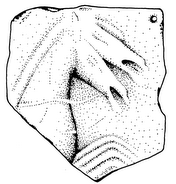The main part of the Karystian Kampos survey ended with the 2007 season and we have had very important and somewhat unexpected results (see below). Especially significant were our findings of prehistoric remains in parts of the Kampos where we thought they would be covered by alluvium. Moreover, our prehistoric sites almost exclusively consist of lithic (obsidian) scatters, however of the size and magnitude not previously recorded in the area. This has further corroborated the hypothesis that the Karystia was an important part of the prehsitoric obsidian trade/exchange (e.g. Keller et al. (forthcoming) "Prehistory of the Paximadhi Peninsula", Instap Publications). Our work in 2008 was geared towards trying to obtain even more information from the lithics sites.
Our aim was to conduct detailed on-site micro-survey of selected sites to collect the material we might have missed previously. We chose the largest obsidian scatter (findspot 07N35) as our 2008 target. With two intersecting N-S and E-W axes we divided the location into 4 sectors. Each sector was further subdivided into E-W running transects, which were in turn subdivided into 2X2 m squares. The 2X2 m squares served as our basic recording units. Each square was collected in detail by a 2 person team. During the 2-week period we were able to survey most of one of the sectors. As we expected, we collected a lot more material that we missed in 2007 and which consists mainly of microflakes and larger fragments probably uncovered by erosion during the time between the last visit we made to the site in 2007. These types of materials are very important for understanding the exact nature of the site and for statistical analyses.
The team in the field consisted of Rie Larsen, Mia Toftdal, Renate Storli, Davor Cakanic, Svein Hauge, and Zarko Tankosic (field director). This field season was also funded by a grant from the Institute for Aegean Prehistory (INSTAP), for which we are extremely grateful. Last, but by no means the least, I would like to extend special thanks to Ms. Maria Kosma, the archaeologist of the Greek Archaeological Service in charge of southern Euboea, for her understanding, company, and great help in facilitating our research.





No comments:
Post a Comment